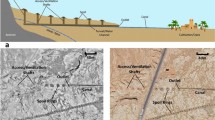Abstract
We evaluated the use of spatial sampling and satellite images to identify deforested areas in Wonju, South Korea. The changes in land cover were identified using a grid of sample points overlaid onto medium and high-resolution remote sensing (RS) satellite images. Deforestation identified in this way (hereafter, RSD) was compared to administrative data on deforestation. We also compared high-resolution satellite images (HR-RSD) and actual deforestation based on categories which were Intergovernmental Panel on Climate Change data. RSD generated by medium-resolution satellite images overestimated the amount of deforested area by 1.5–2.4 times the actual deforested area, whereas RSD generated by HR-RSD underestimated the amount of deforested area by 0.4–0.9 times the actual area. The highest degree of matching (90 %) was found in HR-RSD with a grid interval of 500 m and the accuracy of HR-RSD was the highest, at 67 %. The results also revealed that the largest cause of deforestation was the establishment of settlements followed by conversion to cropland and grassland. We conclude that for the identification of deforestation using satellite images, HR-RSD with a grid interval of 500 m is most suitable.




Similar content being viewed by others
References
Bae JS (2007) Negotiation prospects on reducing emissions from deforestation in developing countries under the United Nations framework convention on climate change. Korean J For Econ 15:67–79
Choi SI, Bae JS, Jung BH (2006) Discussions on carbon account in harvested wood products and effects on korean carbon emissions under the UNFCCC. J Korean For Soc 95:405–414
Foody GM (2002) Status of land cover classification accuracy assessment. Remote Sens Environ 80:185–201
IPCC (2006) Marrakesh accords decision 16/CMP.1 (land use, land-use change and forestry), pp 4–6
Japan Forestry Agency (2008) Forest carbon sinks inventory information development project (detection of land use change using satellite imagery). Japan Forestry Agency, Tokyo, pp 205–219
Jensen RJ (2005) Introductory digital image processing: a remote sensing perspective, 3rd edn. Sigma Press, Seoul, pp 338–352
Jung HS (2011) Results and implications of durban conference of the parties. Trade Focus 10:1–20
Kim KM, Lee JB, Kim ES, Park HJ, Roh YH, Lee SH, Park KH, Shin HS (2011) Overview of research trends in estimation of forest carbon stocks based on remote sensing and GIS. J Korean Assoc Geogr Inf Stud 14:236–256
Korea Forest Research Institute (2011) 6th national forest inventory and forest health monitoring-field survey guide book Version 1.1, Seoul. http://www.nfric.or.kr/. Accessed 15 Nov 2014
Korea Forest Service (2000) Forest and forestry technology III. Samjung Press, Daejeon, pp 254–256
Korea Forest Service (2008) Response to climate change forest comprehensive plan. Korea Forest Service, Daejeon, pp 9–67
Korea Forest Service (2010) Statistical yearbook of forestry. Korea Forest Service, Daejeon. http://www.forest.go.kr/. Accessed 15 Nov 2014
Korea Forest Service (2011) Statistical yearbook of forestry. Korea Forest Service, Daejeon. http://www.forest.go.kr/. Accessed 15 Nov 2014
Korea Forest Service (2012) Development of quantification and verification technique of forest-carbon change using remotely sensed data. Korea Forest Service, Daejeon, pp 29–62
Korea Forest Service (2013) Statistical yearbook of forestry. Korea Forest Service, Daejeon. http://www.forest.go.kr/. Accessed 15 Nov 2014
Korea Forest Service (2014) Statistical yearbook of forestry. Korea Forest Service, Daejeon. http://www.forest.go.kr/. Accessed 04 Jun 2015
Ku JY (2007) Generation of the land cover map with high-resolution satellite image. Geogr J Korea 41:83–94
Ku JY (2011) A study on managing and processing the images with different spatial resolution for the systemic land cover classification. Geogr J Korea 45:375–384
Kwon SD, Seo JH, Son YM, Park YK (2005) Biomass carbon emissions according to conversion of forest land in Korea. For Bioenergy 24:10–15
Lee KS, Yoon YS, Kim SH, Shin JI, Yoon JS, Kang SJ (2009) Analysis of present status for the monitoring of land use and land cover in the Korean Peninsula. Korean J Remote Sens 25:71–83
Lee HJ, Ru JH, Yu YG (2010) Extracting high quality thematic information by using high-resolution satellite imagery. Korea Soc Geospat Inf Syst 18:73–81
Sung CJ, Lim IS (2008) A objective study of non-coincidence between land category in cadastral map and land cover classification using satellite images. J Korean Assoc Geogr Inf Stud 10:177–190
Wonju (2014) Administration Statistics sourcebook. Wonju. http://stat.wonju.go.kr/. Accessed 04 Jun 2015
Wu W, Shao G (2002) Optimal combinations of data, classifiers, and sampling methods for accurate characterizations of deforestation. Can J Remote Sens 28:601–609
Author information
Authors and Affiliations
Corresponding author
Additional information
The online version is available at http://www.springerlink.com
Corresponding editor: Yu Lei
Rights and permissions
About this article
Cite this article
Park, J., Lee, J. Detection of landuse/landcover changes using remotely-sensed data. J. For. Res. 27, 1343–1350 (2016). https://doi.org/10.1007/s11676-016-0270-x
Received:
Accepted:
Published:
Issue Date:
DOI: https://doi.org/10.1007/s11676-016-0270-x




